The Lives of the Stars
(Atom Production, Stellar Phenomena)
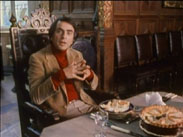 |
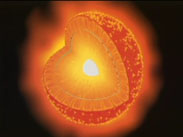 |
Cosmos
by Carl Sagan
A Personal Voyage
13 episodes
|
See below for
DVD purchasing options
|
|
(Carl Sagan's Cosmos episode no. 9)
- written by Carl Sagan and Ann Druyan & Steven Soter
- series director & executive producer Adrian Malone
- Cambridge sequences directed by David Kennard
- Spaceship and studio sequences directed by Rob McCain
- American sequences directed by David F. Oyster
- Video Effects sequences directed by Richard J. Wells
- edited by James Latham (film) and Roy Stewart (videotape)
- Main Title Theme by Vangelis
- Music by Vangelis, Synergy,
Wm. Jeffery Boydstun, and others...
- 1 documentary @ 59 minutes
|
Data Capsule Review
|
|
by Martin Izsak
|
This is, I think, the best episode in the second half
of Sagan's "Cosmos" series. Apart from one later cartoony section,
the visuals and music are particularly exceptional here.
The subject matter is also fascinating all the way through
and fairly solid.
The two main ideas - atom production and the life cycle of stars
- relate to each other nicely, and Sagan is in top form
expressing the details and history of the concepts with enthusiasm
and clarity.
|
Participants include:
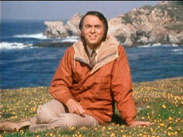 |
Dr. Carl Sagan
Astronomer, host, narrator
Voyager imaging team
Professor of Astronomy and Space Sciences,
Cornell University, Ithaca, New York
|
|
Atoms of Cambridge
The first 1/3 of the episode is centered in and around Cambridge university,
where atomic structure was first discovered. Sagan gives quite a complete
explanation of atoms here, from size and scale, to their composition
from the building blocks of protons, neutrons, and electrons, and the various
forces that need to be rebalanced to put things together. These sequences
are kept lively by creative use of the location and many different props.
Quite good.
Since this sequence is primarily concerned with all you need to know for
the later stellar phenomena sequences, it doesn't quite go far enough
to cover topics like ions (basically atoms that do NOT have the right number
of electrons to be electrically balanced), or the concept of building molecules
out of atoms, which could get us into valences and completing various electron orbit
shells. Perhaps that should ideally be in a different episode if done at all though,
because the atomic section that we do get is a hefty chunk in itself, after which
the episode makes a stylistic and visual shift, and enjoys a burst of new energy
as it tackles some different ideas altogether.
Suns and Supernovae
The episode makes a successful return to outer space and the depths of time
for its next segment. We begin with a review of what we know about the
composition of our own sun, and the processes at work there. This is a visually
beautiful stretch of the program. Modern presentations of the show feature
some excellent full motion CGI, which is mixed with actual scientific photography
and film of our own sun's churning gases and corona, ejecting plumes of material
into space. Sagan then describes the details of the changes the sun will
undergo in its lifetime, and contrasts this with other types of stars. This
he does very nicely and succinctly, such that viewers are prompted to come out
of this episode with a very clear idea of what many celestial objects are,
and what it is that makes them different or special.
But the most definitive sequence of the episode comes next, as Sagan takes us in
the familiar Ship of the Imagination to witness a supernova explosion. It's
about the only time in the series that we get a bit of high tension and drama
in the ship, which helps the sequence stand out a bit. Some of the graphics
don't seem very modern, but they have a unique bit of charm to them. How well-built
is Sagan's ship? How many of these forces can it withstand? The sequence wraps
up by connecting the dots appreciably. It is thanks to prior Supernova explosions that
we get to enjoy all the heavier atomic elements that these big powerful stars
fused and synthesized in their interiors.
One thing I always found a bit creepy is the casual way
Sagan handles radioactive uranium in the cave,
adding only a pair of gloves to his usual outfit.
It doesn't seem too surprising to me then, that he passed
away at an early age....
Another most memorable bit is the portrayal of the timespan of
Human observations of the Crab Nebula - ancient cultures recording
what was likely a supernova explosion in that location, while
modern astronomers regard the nebula as the gaseous outer shell
of that supernova, and the rapidly spinning pulsar in the center
as the supernova's core remains.
The details of what a pulsar is
kick off the episode's final segment of wilder ideas of various
space phenomena that may be out there, and the wilder branch of
physics that may support those types of objects. There's quite
a large variety of things here, such that new things continue to
pop out on subsequent viewings. Before it's all over,
Sagan gets quite poetic and excited about it all, and the episode
comes to a grand, exciting, and once more visually exquisite conclusion.
In terms of having any content I might have a disagreement with,
the episode has so far felt fairly pure to me. There are a few hints
at limiting evolutionary possibilities, but these are quite
faint ghosts of material already tackled head-on in
episode 2. There's also a tiny bit
about Einstein's theories to support the concept of
black holes. I don't know if any aspect of this might
one day seem dated, but black holes currently still work for me,
and Sagan does present them in a milieu of fascinating speculative ideas.
I am, however, reminded of a quote from MIT scientist Max Tegmark
in the special Universe episode
"Beyond the Big Bang",
when he covered some of the various arguments in the debate as
to what Dark Matter could possibly be:
"Some people think it's just a reflection of the fact
that we might have gotten our gravity wrong... again."
I'll put my hand up as one of those people,
in the belief that some holes in the calculations for gravity
and/or Einstein's relativity are the main reasons for proposing
ideas like Dark Matter or Dark Energy, and that we'd be better
off working backwards to find our mistakes
than in avalanching forwards into new arenas of crap and falsehoods.
Will gravity itself turn out to be some grand mislabeling of
magneto-electric force? If so, it could make a nonsense of
much of what this Cosmos episode is about. I'm intrigued,
but far from being convinced at this time.
But, you've gotta love the supernova sequences, the pulsars,
the discussion of the Crab Nebula as it was observed down
through history, and the sequence of wrapping Cambridge up
in a Googolplex as though it was a sophomore prank.
Yes, episode 9 here is one of the better ones,
and a good highlight to look forward to during the later
parts of the run.
|
International Titles:
Deutsch: Unser Kosmos - "Das Leben der Sterne"
Español: Cosmos - "La vida de las estrellas"
Magyar: Kozmosz - "A Csillagok életre kelnek"
Русский: Космос - "Жизнь звёзд"
Français: "La vie des étoiles"
Italiano: "La vita delle stelle"
|
|
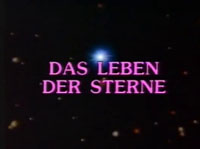
|
As always, the edits made for the German 42-44 minute cut-down version "Unser Kosmos"
are a point of fascination for me. Episode 9 turns out to be
one of the better edits for the series.
The first cut for episode 9 was a good one - going directly from the candle flame
in the mirrors in the dining room to footage of uranium atoms, thus cutting
out the discussion of large numbers written out exponentially, and the Googolplex
prank that moved Sagan to a new room in the college. Let's face it, that part
was a bit off-topic, and the Cambridge section is much more pithy, getting back
to space images in a timely fashion before audience interest can dissipate.
Surprisingly there isn't another noticeable cut until Sagan is all finished irradiating
himself in the cave, and then it's a big one that finds him sitting on the
grassy beach cliff already. For my money, they should have left the cave
radiation bit out, because the demonstration of a pulsar's rotation increasing
as it pulls its mass inwards (akin to the figure skater) is a sequence that
is an absolute must. Time permitting, the native depiction of the Crab Nebula
is the next most important thing to include. And yes, the cartoony bits
are the most likely to hit the cutting room floor; no arguments there.
The Music - Episode 9 - The Lives of the Stars
In 1980, the original Cosmos had a somewhat different musical background
to what is now found in the 2000 Collectors' Edition on DVD and Blu-ray.
Episode Nine in particular seems to feature more differences than most other episodes.
So, when we decided to roll out new music charts for Cosmos that list
both soundtracks simultaneously, so that readers can see what changed
and what stayed the same, this episode was where we started.
It is interesting to note
how the two versions often aim for the same tone and style, yet
find their solutions from very different sources of varying
recording quality....
Compositions that were unique to the original
1980 version are typically shaded blue-grey. Compositions that
remained the same for both versions are stretched out across both
sets of columns, even though Cosmos doesn't necessarily use
the same recording or excerpts of that composition.
Exact sync cannot be expected in these cases either,
as the new version features a completely new re-dub of all music.
And as before, anything written in green text
represents a name I made up to help keep some music better identified in my own head.
| Collectors' Edition 2000 (DVD) |
Original 1980 | |
| Composer/Performer | Title 2000 |
Composer/Performer | Title 1980 | Notes |
| Vangelis | Symphony to the Powers B, Movement Three
also known as "Theme from Cosmos" |
Title Music |
| Wm. Jeffery Boydstun | Life Cycle |
Ralph Vaughan Williams
Klaus Schulze |
Job: Scene 6 of 9 (excerpts)
Job: Fanfare from Scenes 1b & 8
Bayreuth Return |
cosmic ingredients
baking heat |
| Gottfried Finger |
Sonata in C-Major for
Trumpet, Oboe, Basso Continuo
Movement 1 of 4:
|
Joseph Haydn
/ Maurice André |
Trumpet Concerto in E-flat Major
End of Movement 1 of 3
More about the
exact recording here.
|
Pie is served. |
| Johann David Heinichen | Concerto S233 for
2 Horns and 2 Flutes in F Major
Movement 2 - Andante poco Allegro |
Benedetto Marcello | The Golden Sound, Side A, Track 1
Sonata in Crumbly B Goode
- Movement 1 of 4: Adagio
What's this? |
"Suppose we
cut a piece..." |
| Vangelis | Alpha (original version) | |
| Richard Harvey | Migration | Terry Riley | Persian Surgery Dervishes:
Performance Two, Part 2 (middle) | infinity |
| Joseph Haydn | Trumpet Concerto in E-flat Major
Movement 3 of 3 (infamous melody) | Cambridge
wrapped in a roll
of "Googolplex" |
| Vangelis | Alpha (remastered version) |
Alpha (original version) | |
| Gottfried Finger | Sonata in C-Major for
Trumpet, Oboe, Basso Continuo
Movement 1 of 4:
"King of Pies" |
Michael Haydn | Trumpet Concerto in D-Major MH104
Movement 1 of 2: Adagio (excerpt)
(and struggling with high notes) | table of elements |
| Wm. Jeffery Boydstun | In Motion Delta 01
continuing into
In Motion Delta 02 |
Steve Reich
Terry Riley
|
Music for 18 Musicians (start)
Persian Surgery Dervishes:
Performance Two, Part 2 (cont.) |
|
| Wm. Jeffery Boydstun | Metamorphosis |
Heldon | Perspective I | |
| Vangelis | Alpha (remastered version) |
Alpha (original version) |
(Cambridge
section ends) |
| Vangelis | Comet 16 |
Jean Michel Jarre | Equinoxe No. 1 of 8 | (Star section begins) |
| Clem Alford | Raga Sind Bhiravi | Paul Horn in India | Raga Bihag | 21:54 - 22:36 |
| Larry Fast / Synergy | Legacy | |
| Vangelis | Alpha (remastered version) |
Alpha (original version)
|
| Ralph Vaughan Williams - Job: Scene 6 of 9 |
| |
|
(no music for several minutes)
| |
| ?? Vangelis? | "Ghost of the Sun"
??Comet Movement
unused in
1986 special edition? |
Edgar Froese
Henri Pousseur
Toru Takemitsu
Toru Takemitsu
Henri Pousseur
|
Maroubra Bay (near end)
Trois Visages De Liège #1 of 3
"L'Air Et L'Eau" (~middle)
A4. Kokorono Nakano Uchu
A5. Taiyo Shinden
Trois Visages De Liège #1 of 3
"L'Air Et L'Eau" (~end)
|
(faint, under
other cues)
(In the Heart
of the Universe)
(twice)
(continuing
into foreground)
|
| Larry Fast / Synergy | Delta Four (quiet bits only) | |
| Igor Stravinsky | The Rite of Spring - Part 1: The Adoration of the Earth
section 2 of 7: "Augurs of Spring"
(this portion does NOT appear on Voyager's Golden Record) | pre-nova suspense |
| Vangelis |
| Spiral | | (strangely, only the last minute of this song is used,
despite that the opening would have been awesome here) |
| post-nova spectacle |
| Pink Floyd | One of These Days | |
| Dmitri Shostakovich | Symph. 5 Mvmt. 3,
"Requiem" excerpt |
Le Orme | Notturno | |
| J.S. Bach / Isao Tomita | The Sea Named "Solaris" |
Pulsar | Misty Garden of Passion | |
| John Coloff | Flute Call
Cry from the Earth, Side B, Track 10 | 39:10 - 39:59 |
| ?? Vangelis? | ??Comet Movement? - The Big Burn
40:10 - 41:20 |
Larry Fast / Synergy | Delta Two (continuing into...) | |
| Larry Fast / Synergy | Delta Four (hard & fast random electronic pulse-notes) | backing the
rotating Pulsar |
| Vangelis | Comet 16 begins |
Jean Michel Jarre | Equinoxe No. 1 of 8 | |
| Alec Gould | Masque - (formerly listed as
"Cheshire Gravity, Flatland, and
Foot People") (humorous waltz for strings) |
Benjamin Britten | Variations on a
Theme of Frank Bridge
Part 1 of 2, Section 6 of 7 | (gravity at play) | |
| Vangelis | Comet 16 concludes |
Klaus Schulze | Bayreuth Return
(Album: Timewind) | | |
| ?? Vangelis? | ??Comet Movement? - Venus Goes Digital
47:17 - 47:58 |
Jean Michel Jarre | Equinoxe No. 3 of 8 | |
| ?? Vangelis? | ??Comet Movement? - Pristine
(The piece begins properly here...) |
Jean Michel Jarre | Equinoxe No. 4 of 8 | |
| Larry Fast / Synergy |
Legacy - (nice long 4.5 minute excerpt used)
| |
| Vangelis | Theme from Cosmos | |
| J.S. Bach / Isao Tomita | The Sea Named "Solaris" | n/a | Cosmos Update |
| ?? Vangelis? | ??Comet Movement? - Pristine
(A clever edit mixing to the last two notes
allows this piece to conclude early.)
| ...(Theme from Cosmos continues...) | (over the end credits)
|
| Vangelis | Comet 16 | n/a | Collector's Edition 2000 Credits |
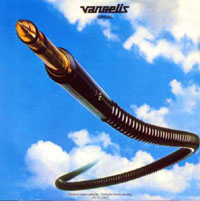
Vangelis
Spiral
Original music
composed by
Vangelis
Audio CD
The last minute
of the title track "Spiral" appeared in "Cosmos",
even though little of its distinctive opening
was heard at that point, making it one of the more
unrecognizable uses of Vangelis music.
|
Spiral: Remastered Edition 2013:
Spiral 2013
All Tracks by Vangelis
This album available on CD only.
Track Listing:
1. Spiral
2. Ballad
3. Dervish D
4. To the Unknown Man
5. 3 + 3
6. To the Unknown Man (Part Two) - CD only
|
Spiral - original Audio CD:
Vangelis - Greatest Hits
All Tracks by Vangelis
This album available on CD or MP3 download.
Track Listing:
1. Spiral (6:57)
2. Ballad (8:29)
3. Dervish D (5:13)
4. To the Unknown Man (9:06)
5. 3 + 3 (9:35)
U.S. 2009 alternate


|
|
|
|
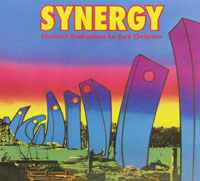
Synergy
Electronic Realizations for Rock Orchestra
Original music
composed by
Larry Fast as Synergy
Audio CD
|
Electronic Realizations for Rock Orchestra:
|
Synergy - Electronic Realizations for Rock Orchestra
All Tracks by Larry Fast as Synergy
This album available on CD or MP3 download.
Track Listing:
1. Legacy (10:10)
2. (s)Laughter on Tenth Avenue (11:54)
3. Synergy (5:30)
4. Relay Breakdown (6:25)
5. Warriors (12:58)
|
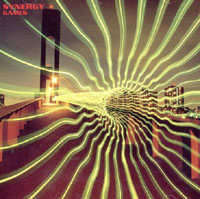
Synergy
Games
Original music
composed by
Larry Fast as Synergy
Audio CD
|
Games:
|
Synergy - Games
All Tracks by Larry Fast as Synergy
This album available on CD or MP3 download.
Track Listing:
1. Delta Two (5:42)
2. Delta Four (6:14)
3. Delta One (7:35)
4. Delta 3/A (2:23)
5. Delta 3/B (2:11)
6. Delta 3/C (4:02)
7. Delta 3/D (3:05)
8. Delta 3/E (2:18)
9. Delta 3/F (4:47)
|
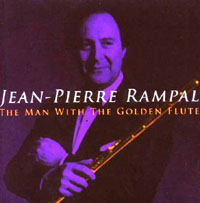
Jean-Pierre Rampal
The Golden Sound / The
Man With the Golden Flute
| Jean-Pierre Rampal - flute |
| Mario Duschenes - | 2nd flute /
recorder |
| Kenneth Gilbert - harpsichord |
Orion Master Recordings
It is likely that this was the
go-to album for flute pieces when music was first
tracked onto Cosmos. Not only is the first
piece here in episode 9, but cue sheets
indicate that every other composition
made an appearance somewhere in the original
1980 version.... However, many of the changes
to Cosmos music were due to copyright issues,
and ALL cues from this record were replaced
in the 2000 Collectors' Edition on DVD and Blu-ray.
It also seems that whoever first compiled the cue sheet
for episode nine mistakenly copied the information from
side B's first track, when side A's first track was
actually used on the program.
|
2008 CD: The Man with the Golden Flute
The Man with the Golden Flute 2008
Acrobat Music - ACRCD315
This album available on CD.
Track Listing:
1. Benedetto Marcello - Sonata in B, Op. 2 (1712)
2. Johann Ludwig Krebs - Suite (Sonata) in G
3. Georg Philip Telemann - Duo-Sonata in E Op. 2 for Two Flutes
4. Johann Christoph Pepusch - Trio Sonata in G
5. J.S. Bach - Air (from Suite in D)
U.S. On-Demand
CD-R:


|
|
|
|
Vinyl LP 1973 - The Golden Sound:
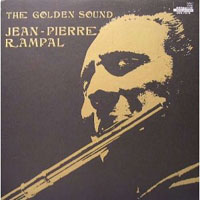
Get more info and/or buy
Jean-Pierre Rampal - The Golden Sound
at Discogs.com.
The Golden Sound 1973 - Jean-Pierre Rampal
Orion Master Recordings Inc. ORS 73114
This album available on vinyl.
Track Listing:
A1. Benedetto Marcello - Sonata in B minor, Op. 2 (1712) (6:50)
A2. Johann Ludwig Krebs - Suite (Sonata) in G (13:34)
B1. G. P. Telemann - Duo-Sonata in E, Op. 2 for 2 Flutes (11:15)
B2. Johann Christoph Pepusch - Trio Sonata in G (8:20)
B3. J.S. Bach - Air (From Suite in D) (3:17)
In all honesty, I hesitate to promote the listed
title of the first track, since the music seems
to have no connection with the key of B natural minor,
and is not among the 12 sonatas in
Marcello's Opus 2 published in Venice in 1712.
I'm still keen to match this tune to some sheet music,
or hear another recording of it, to see what
other title(s) it might be going by.
To my ear, Rampal's performance of "Crumbly B Goode"
seems to be in E-minor, slightly detuned downwards
by about 1/4 of a semitone. There are four movements
described as
(1) Adagio, (2) Allegro, (3) Largo, and
(4) Allegro.
It has ONE FLUTE leading with a melody,
while the harpsichord plays bassline accompaniment.
By contrast, the Telemann piece opening the flip-side
is what the album cover says it is:
one of the six TWV 40 sonatas
(often the one listed as #102) in 4 movements:
(1) Largo, (2) Allegro, (3) Affettuoso, (4) Vivace.
It has TWO FLUTES sharing the melodic lead equally,
and NO harpsichord or other bassline accompaniment.
...and it was not used in Cosmos episode 9
as reported by many other cue sheets.
Telemann's piece does have better luck
with its listing in
Episode 2's 1980 soundtrack...
|
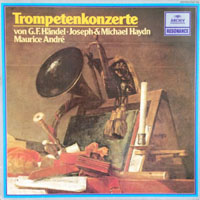
Maurice André
Trompetenkonzerte
Recordings reissued under
Deutsche Grammaphon
Audio CD, mp3 Download, Streaming
|
Trompetenkonzerte: CD, mp3, stream
Trompetenkonzerte - Maurice André
Deutsche Grammaphon re-issue
This album available on CD, mp3 download, or streaming.
Track Listing:
---- Haydn: Trumpet Concerto in E Flat Hob.VIIe:1 ----
18. Mv. 1 - Allegro (6:30)
19. Mv. 2 - Andante (4:02)
20. Mv. 3 - Allegro (4:32)
---- M. Haydn: Trumpet Concerto in D Major ----
16. Mv. 1 - Adagio (7:23)
17. Mv. 2 - Allegro (3:14)
---- Viviani: Sonata Prima For Trumpet and Continuo
1. Mv. 1 - Andante (1:37)
2. Mv. 2 - Allegro (1:20)
3. Mv. 3 - Presto (1:24)
4. Mv. 4 - Allegro (1:35)
5. Mv. 5 - Adagio (1:05)
---- Vivaldi: Concerto for 2 Trumpets, Strings and Continuo RV537 in C Major
6. Mv. 1 - Allegro (3:11)
7. Mv. 2 - Largo (0:57)
8. Mv. 3 - Allegro (3:27)
---- Telemann: Concerto-Sonata in D Major for Trumpet, Strings and Harpsichord
9. Mv. 1 - Moderato e grazioso (3:25)
10. Mv. 2 - Largo (4:08)
11. Mv. 3 - Vivace (2:46)
---- Handel: Oboe Concerto No.3 in G minor HWV 287 played on trumpet
12. Mv. 1 - Grave (3:02)
13. Mv. 2 - Allegro (1:43)
14. Mv. 3 - Sarabande: Largo (1:56)
15. Mv. 4 - Allegro (1:50)
|
Vinyl LP - Trompetenkonzerte:
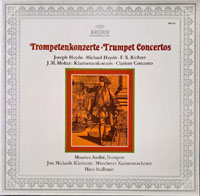
Get more info and/or buy
Maurice André - Trompetenkonzerte, Archiv 198415
at Discogs.com.
Trompetenkonzerte - Trumpet Concertos - Maurice André
Archiv Produktion - 198 415
This album available on vinyl.
Track Listing:
A1. Joseph Haydn - Konzert Für Trompete & Orch. Es-dur (14:35)
----Mv. 1 - Allegro (6:19)
----Mv. 2 - Andante (3:57)
----Mv. 3 - Allegro (4:20)
A2. Michael Haydn - Konzert Für Trompete & Orch. D-dur (10:28)
----Mv. 1 - Adagio (7:14)
----Mv. 2 - Allegro (3:10)
B1. Franz X. Richter - Konzert Für Trompete & Orch. D-dur (14:52)
----Mv. 1 - Allegro Moderato (4:57)
----Mv. 2 - Andante (5:24)
----Mv. 3 - Allegro (4:22)
B2. J. M. Molter - Konzert Für Klarinette & Orch. G-dur (13:45)
----Mv. 1 - Concerto (Moderato) (5:34)
----Mv. 2 - Adagio (5:44)
----Mv. 3 - Allegro (2:00)
Tracks A1, A2 & B1 recorded in München (Munich) 1966 Nov.
Track B2 recorded in München 1959 Oct.
Early in episode 9, Cosmos uses the trumpet cadenza
from the end of Joseph Haydn's Concerto in E flat
movement 1. Since the solo player performing such
a cadenza will improvise to create his or her own
unique virtuoso performance of the piece, only
Maurice André's 1966 recording here will
match what you hear in Cosmos note-for-note.
So, this is THE recording that Cosmos fans will
truly want.
|
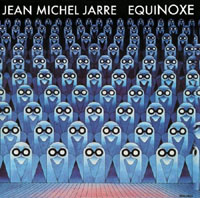
Jean-Michel Jarre
Equinoxe
Original music
composed by
Jean-Michel Jarre
Audio CD
|
Equinoxe:
|
Jean-Michel Jarre - Equinoxe
All Tracks by Jean-Michel Jarre
This album available on CD or MP3 download.
Track Listing:
1. Equinoxe Part 1
2. Equinoxe Part 2
3. Equinoxe Part 3
4. Equinoxe Part 4
5. Equinoxe Part 5
6. Equinoxe Part 6
7. Equinoxe Part 7
8. Equinoxe Part 8
|
This documentary has become available on DVD.
Cosmos - by Carl Sagan: A Personal Voyage
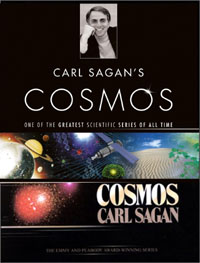
13 hour-long episodes, 1980
|
U.S.


| Canada


| U.K.


|
Comments on this article are welcome. You may contact
the author from this page:
Contact page
|


















